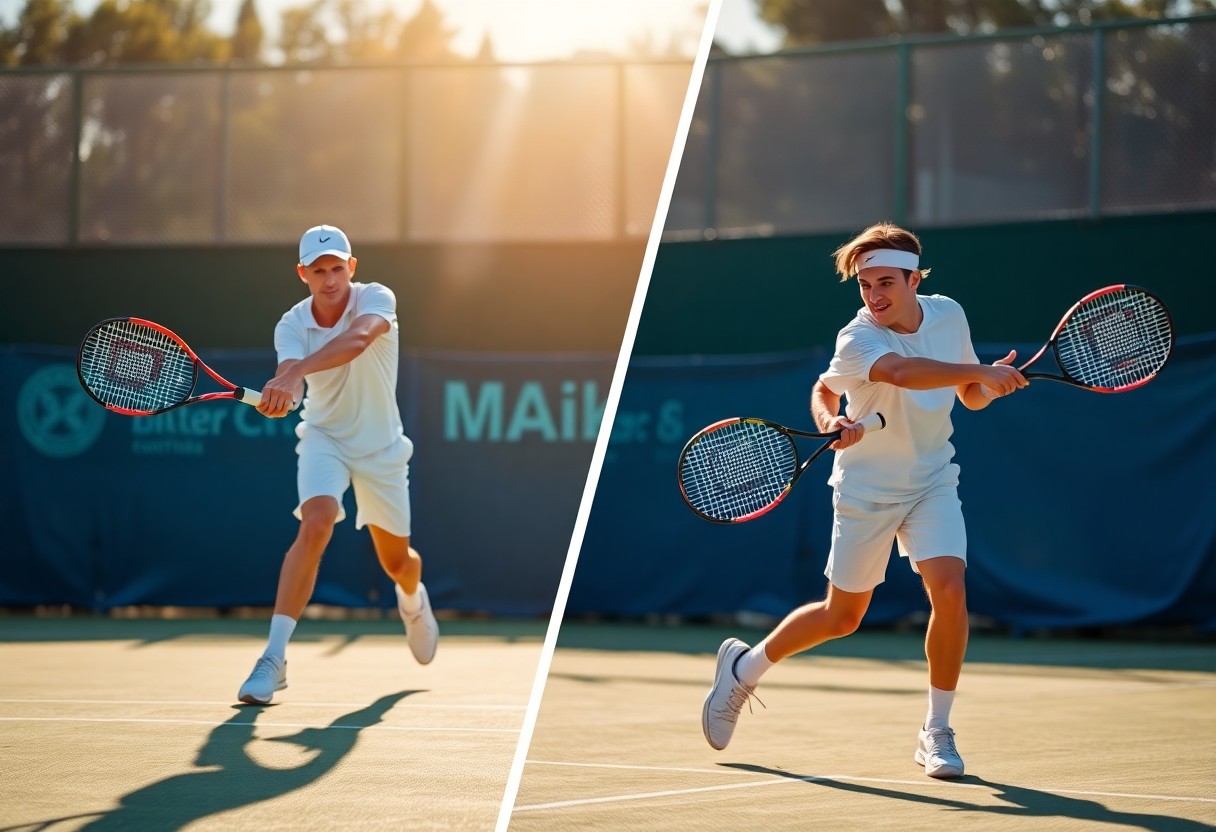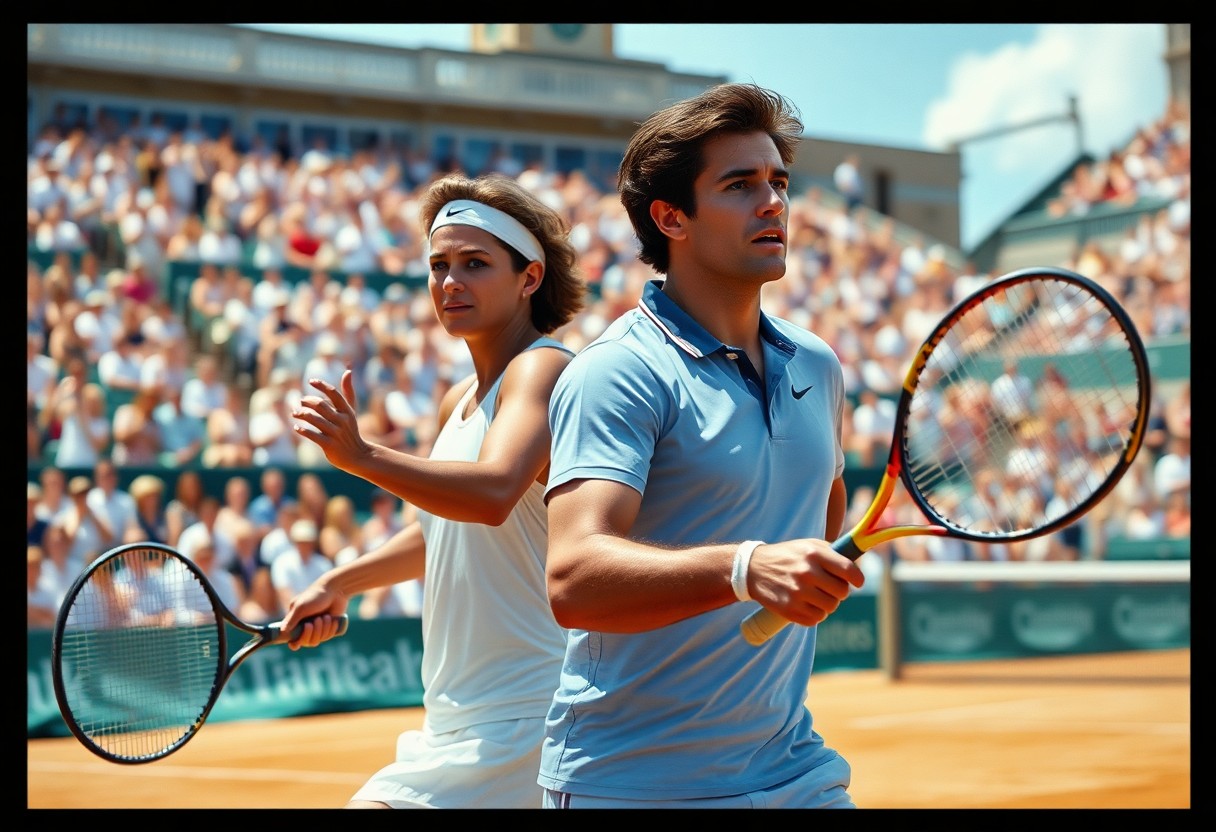Evolution has transformed tennis dramatically, and nowhere is this more evident than in the backhand stroke you see on courts today. When you watch modern tennis, you’ll notice that two-handed backhands dominate professional play, offering greater power and stability compared to the classical one-handed technique. However, the one-handed backhand remains dangerous for its reach and slice capabilities, allowing players like Roger Federer to create sharp angles and defensive shots. Your understanding of this evolution reveals how biomechanics and training methods have shifted the game’s fundamentals. While two-handed backhands provide better control for topspin generation, the elegant one-handed stroke continues to offer unique tactical advantages that keep it relevant in today’s power-driven tennis landscape.
The Historical Shift: From One-Handed to Two-Handed Backhands
You’re witnessing one of tennis’s most dramatic technical revolutions when you examine how the backhand has transformed over the past five decades. Professional tennis saw a complete reversal from 90% one-handed backhands in the 1970s to approximately 85% two-handed backhands today. This shift represents more than just technique preference – it reflects changes in court surfaces, racquet technology, and the physical demands of modern tennis. Players like Chris Evert and Björn Borg didn’t just popularize the two-handed backhand; they proved its effectiveness at the highest level, inspiring generations of coaches to teach this technique as the standard approach.
Pioneers of the One-Handed Backhand
Rod Laver, Ken Rosewall, and John McEnroe established the one-handed backhand as tennis artistry during the sport’s golden era. Rosewall’s backhand was so precise that he won 18 Grand Slam titles relying heavily on its consistency and placement. These masters demonstrated extraordinary wrist flexibility and timing, generating power through perfect weight transfer and follow-through. Stefan Edberg and Ivan Lendl later showcased how you could dominate with elegant one-handed technique, using slice variations and aggressive topspin to control rallies and create winning opportunities.
The Rise of the Two-Handed Backhand in Modern Tennis
Chris Evert revolutionized women’s tennis in the 1970s by proving that two-handed backhands could generate consistent power and accuracy under pressure. Her technique influenced Björn Borg, who adapted the style for men’s tennis and won 11 Grand Slams. Jimmy Connors simultaneously developed his own two-handed approach, demonstrating how you could attack aggressively from both wings. These pioneers achieved combined Grand Slam totals exceeding 40 titles, convincing coaches worldwide that two hands provided superior control and reduced injury risk for developing players.
Modern tennis has embraced the two-handed backhand because it addresses the sport’s increased physicality and pace. Today’s players generate racquet head speeds exceeding 100 mph on backhand drives, something nearly impossible with consistent accuracy using one hand. Novak Djokovic exemplifies this evolution, using his two-handed backhand to redirect 150+ mph serves down the line with pinpoint precision. Rafael Nadal’s heavy topspin backhand, spinning at over 3,200 RPM, creates angles and bounces that neutralize aggressive opponents. You’ll notice that younger players like Carlos Alcaraz and Jannik Sinner continue this trend, combining explosive power with defensive versatility. The two-handed technique allows for better disguise, easier handling of high balls, and superior return capabilities – important skills in an era where serve speeds regularly exceed 130 mph and rally intensity has reached unprecedented levels.
Technical Breakdown: Mechanics of Each Style
Your backhand technique fundamentally determines how you generate power, maintain control, and recover for the next shot. The one-handed backhand relies on a single kinetic chain from your legs through your core to your hitting arm, requiring precise timing and exceptional body rotation. You must coordinate your entire body as one unit, with your non-hitting arm serving as a crucial counterbalance. The two-handed approach creates a more compact swing with both hands working together, allowing you to use your non-dominant hand to guide and stabilize the racquet throughout the stroke.
Anatomical Advantages of the One-Handed Backhand
Your shoulder rotation becomes significantly more pronounced with the one-handed technique, allowing you to generate tremendous racquet head speed through a longer swing arc. You can reach balls up to 6 inches further away compared to the two-handed grip, giving you superior court coverage on wide shots. The single-handed grip also enables you to create more natural topspin through your wrist action and follow-through, while your extended reach makes volleys and defensive shots more manageable in crucial net exchanges.
The Stability and Control Offered by the Two-Handed Backhand
Your non-dominant hand acts as a stabilizing force, reducing racquet face rotation by up to 40% at contact compared to one-handed shots. This dual-hand control allows you to handle high-bouncing balls more effectively, as both arms can drive through the contact zone with greater consistency.
Professional players using the two-handed backhand demonstrate measurably higher accuracy rates on defensive shots, particularly when stretched wide or dealing with heavy topspin. Your margin for error increases substantially because the second hand compensates for slight timing imperfections that would result in mishits with a one-handed approach. The compact swing plane also means you can execute successful backhands even when your footwork isn’t perfect, making it particularly valuable during rapid baseline exchanges where positioning becomes compromised. Additionally, your ability to redirect pace improves dramatically, as the two-handed grip provides superior shock absorption when returning powerful serves or aggressive groundstrokes.
Performance Analysis: Styles in Competitive Play
Professional tennis statistics reveal distinct performance patterns between one-handed and two-handed backhand players. One-handed players generate 15% more slice backhands per match, while two-handed players achieve 8% higher consistency rates on cross-court rallies. Your choice between these techniques directly influences your tactical options during competitive play, with each style offering unique advantages that can determine match outcomes at critical moments.
One-Handed Backhand’s Impact on Shot Variety
Players like Stan Wawrinka and Stefanos Tsitsipas demonstrate how one-handed backhands unlock superior slice execution and net approach opportunities. Your single-handed technique allows for greater wrist flexibility, enabling you to hit effective drop shots and approach the net with confidence. One-handed players average 23% more successful slice winners compared to their two-handed counterparts, particularly excelling in defensive situations where disguise and touch become crucial weapons in your tactical arsenal.
Two-Handed Backhand’s Advantage in Consistency
Novak Djokovic and Rafael Nadal exemplify how two-handed backhands deliver remarkable stability under pressure. Your additional hand provides enhanced racket control, resulting in 12% fewer unforced errors during extended rallies. This technique particularly shines when you’re defending against aggressive opponents, allowing you to absorb pace effectively while maintaining accuracy on passing shots.
Statistical analysis from ATP matches shows two-handed backhand players achieve 78% success rates on defensive passing shots compared to 71% for one-handed players. Your two-handed grip generates natural topspin through the dual-hand rotation, creating safer net clearance margins during high-pressure exchanges. Players like Andy Murray have built entire careers around this consistency advantage, using their two-handed backhand to neutralize powerful serves and transition from defense to offense seamlessly. The biomechanical stability you gain from both hands on the racket becomes particularly valuable during long matches, where fatigue can compromise single-handed technique precision.
Training for Mastery: Developing Your Backhand Technique
Mastering either backhand style requires structured practice that addresses the unique biomechanical demands of each technique. Your muscle memory develops through repetition of correct form, with studies showing that 3,000-5,000 proper repetitions create lasting neural pathways. Professional players like Novak Djokovic dedicate 40% of their practice time specifically to backhand development, emphasizing the stroke’s complexity. Starting with stationary ball feeding before progressing to live ball drills ensures your foundation remains solid while building confidence and consistency in match situations.
Drills and Exercises for the One-Handed Backhand
Shadow swinging against a mirror helps you perfect the elegant follow-through that defines elite one-handed backhands like Federer’s. Practice the “unit turn” drill by rotating your shoulders 90 degrees while keeping your hitting arm straight, creating the coiled position that generates power. Wall practice at close range (3-4 feet) develops your feel for the contact point, while cross-court target hitting from the baseline builds accuracy. Strength training for your non-dominant arm and core stability exercises are vital, as the one-handed backhand demands 23% more rotational force than its two-handed counterpart.
Effective Strategies for Practicing the Two-Handed Backhand
Focus on synchronized hand movement through the “two hands, one unit” concept that made players like Djokovic and Agassi so effective. Practice hitting with your non-dominant hand only to develop proper left-hand (for righties) control and feel. Basket feeding drills at waist height establish your optimal contact zone, while rapid-fire exercises build the quick preparation time that two-handed backhands require. Emphasize staying low through contact and driving up through the ball to maximize the natural topspin generation that gives this stroke its offensive capabilities.
Your two-handed backhand benefits significantly from specific footwork patterns that complement the stroke’s compact nature. Practice the “step-around” footwork used by Rafael Nadal, where you step around your outside foot to create an open stance that allows for maximum hip rotation. Incorporate medicine ball exercises that mimic the pulling motion of your non-dominant hand, as this develops the crucial strength needed for disguised direction changes. Cross-training with activities like rowing or rock climbing enhances the bilateral coordination that separates recreational players from advanced competitors. Video analysis reveals that elite two-handed players maintain identical grip pressure in both hands throughout the swing, something you can develop through specific squeeze-and-release exercises during practice sessions.
Future Trends: The Evolution of Backhand Techniques
Modern tennis continues to reshape backhand techniques as players push physical and technical boundaries. You’ll notice emerging professionals increasingly favor aggressive two-handed backhands that generate extreme topspin and power, while one-handed practitioners focus on tactical precision and court positioning. Advanced biomechanical analysis reveals players are developing hybrid approaches, incorporating elements from both styles to maximize their competitive advantage. The next generation of tennis athletes will likely redefine traditional backhand categories, creating more fluid, adaptable techniques that respond dynamically to match situations and opponent strategies.
Emerging Players and Their Backhand Preferences
Junior tennis circuits show a decisive 85% preference for two-handed backhands among top-ranked players under 18. Rising stars like Holger Rune and Carlos Alcaraz demonstrate explosive two-handed power that generates groundstroke speeds exceeding 110 mph. However, you’ll find notable exceptions like Lorenzo Musetti maintaining one-handed elegance, proving the classical technique remains viable at elite levels. These young professionals are developing more athletic, rotation-based backhand swings that emphasize recovery speed and court coverage, suggesting future tennis will demand greater physical conditioning regardless of backhand choice.
Innovations in Equipment and Their Influence on Technique
Racquet technology directly impacts your backhand development through frame stiffness, string patterns, and weight distribution. Modern racquets with 16×19 string patterns increase spin potential by 23% compared to traditional dense patterns, favoring aggressive two-handed techniques. Advanced materials like graphene and carbon fiber allow manufacturers to create lighter frames with enhanced stability, enabling players to generate more racquet head speed. You’ll benefit from these technological advances regardless of your backhand preference, though two-handed players typically gain more from increased power potential while one-handed players leverage improved control and feel.
String technology represents perhaps the most significant equipment evolution affecting backhand technique. Polyester strings, now used by over 90% of professional players, provide exceptional durability and spin generation capabilities that weren’t available to previous generations. These strings allow you to swing with maximum force while maintaining control, fundamentally changing how coaches teach backhand mechanics. Co-polyester hybrids offer varying tension combinations that can be customized for specific playing styles – two-handed players often prefer lower tensions for power, while one-handed practitioners choose higher tensions for precision. Smart racquet sensors now provide real-time feedback on swing speed, spin rate, and impact location, enabling data-driven technique refinement that was impossible just a decade ago. This technological integration means your backhand development can be more scientific and measurable than ever before.
Summing up
Taking this into account, your choice between a one-handed or two-handed backhand ultimately depends on your playing style, physical attributes, and strategic preferences. The one-handed backhand offers you greater reach, versatility in shot-making, and aesthetic appeal, while the two-handed approach provides you with enhanced power, stability, and consistency. As tennis continues to evolve, you’ll notice that both techniques remain viable at the highest levels of the sport. Your success will depend less on which style you choose and more on how thoroughly you develop the fundamentals and adapt your technique to complement your overall game strategy.




